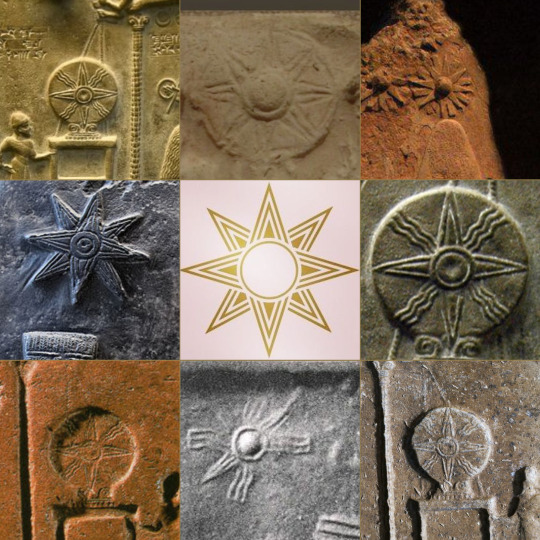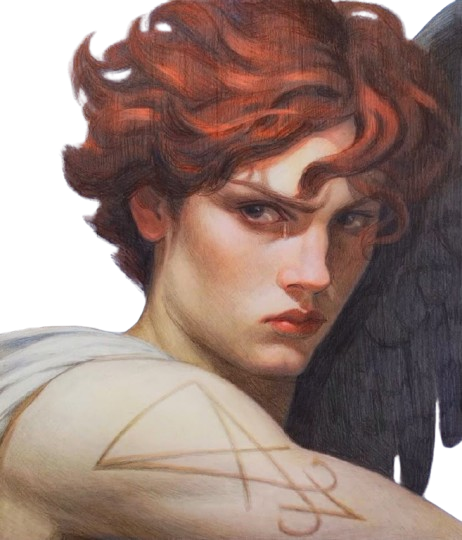𝔱𝔥𝔞𝔱 𝔫𝔞𝔰𝔱𝔶 𝔲𝔤𝔩𝔶 𝔭𝔞𝔤𝔞𝔫 𝔣𝔲𝔠𝔨 𝔱𝔥𝔢𝔶/𝔱𝔥𝔢𝔪 𝔭𝔦𝔢𝔠𝔢 𝔬𝔣 𝔰𝔥𝔦𝔱 𝔏𝔲𝔠𝔦𝔣𝔢𝔯 𝔡𝔢𝔳𝔦𝔩 𝔯𝔞𝔱
Don't wanna be here? Send us removal request.
Text

Gods sometimes he shows me something so beautiful and I can’t help but immediately try to paint it as fast as possible because wow
Lord Lucifer playing the violin 🖤🖤🖤
#lucifer devotee#lucifer deity#theistic luciferianism#digital offerings from others#lord lucifer#luciferian witch#ave lucifer#lucifer offering
160 notes
·
View notes
Text


Happy Pride Month !!! Happy Venus Day!!! Happy Friday the 13th!!!! 💕🖤✴️
The patron and protector of the dolls herself: Lady Aphrodite!
This was so so much fun to paint! I’m so glad I finished it today! I hope I did her justice!
Details!



Big fan of that tummy
I love her sm omgs
499 notes
·
View notes
Text

Anyways idk if we’re still appropriating Christian holidays or what but I celebrate Easter as a holy day for Lord Lucifer as a symbol of rebirth, resurrection and survival after exile. Partially in reference to Ishtar (no eastern doesn’t actually have anything to do with her historically) but also just due to the spring and all that. I consider it like a rite. There are already like a ridiculous amount of parallels between Jesus and Lucifer as the morning stars, but asides from that I just use it as an excuse to celebrate my Lord. If any of y’all Satanists and Luciferians are uncomfortable about Easter I highly encourage you to reclaim it. If you’re being forced to go to church today, just affirm to yourself that you’re not praying to the Christian God, you’re praying to Lucifer.
63 notes
·
View notes
Text

Lucifer from my most vivid dream with him.
For me, Lucifer is dual, combining both solar and lunar energy. This is probably due to the images of Venus as a Morning and Evening star. The Morning star is more sunny, active, fiery. Usually then Lucifer is surrounded by red, pink, orange and warm white. The Evening star is softer. Its colors are opalescent: lavender, blue, pale emerald and of course black.
74 notes
·
View notes
Text
oh sweet helel..

Lucifer is often surrounded by a light haze, like an aura that blurs the boundaries of his body.
340 notes
·
View notes
Text
I love that part in Paradise Lost when Satan is trying to get to earth and he meets Sin and Death for the first time and they’re both like “you’re our dad” and Satan is like “oh… that’s weird… cool i guess, wanna come with me to Earth?” and they’re like oh fuck yeah.
I love it cause he’s not like “what the fuck where did you two come from?” - Like I’m pretty sure he was somewhat aware of Sin considering that she literally came out of his forehead (kind of like Zeus and Athena. huh…) but when Sin is like “yeah and this is our kid, you’re the daddy his name is Death”, Satan is just like “oh. I’m a dad. Interesting. Y’all wanna go on a road trip?” No rejection. No “something as disgusting as you could never have come from me!” no “stay away from me you vile creatures!” just. oh cool :) my kids wanna come to earth too :)
Satan doesn’t reject his children (regardless of how terrible they are) the way his own father rejected him and that’s a pretty interesting detail. Milton could have easily inserted a whole monologue about how much Satan despises his kids. But nah, he’s just generally chill about it.
61 notes
·
View notes
Text
bless be beautiful Ishtar, Inanna.

The star of Ishtar
The Octagram symbol is a star ideogram that commonly appears in ancient Babylonian iconography. The eight-pointed star is usually associated with ancient goddesses such as Ishtar, Innana, Isis and Venus. These goddesses were all seen as protectress of love, fertility, beauty, divine law and power.
The symbol was originally seen as a representation of the seven heavens ruled by the goddess and later became a representation of the planet Venus associated with fertility goddesses. The planet is the third brightest object in Earth's sky after the Sun and the Moon and in the past, it was referred to as the morning or evening star. In the Old Babylonian period, the planet Venus was known as Ninsi'anna translates to "divine lady, illumination of heaven".
In many myths, Inanna’s descend into the netherworld and return to the heavens may correspond with the movements of the planet Venus in the sky, setting in the West and then rising again in the East.
The discontinuous movements of Venus relate to both to the myth as well as Inanna's dual nature. Other theories recognize the story of Inanna's descent into the underworld as a reference to an astronomical phenomenon associated with retrograde Venus.
The symbol refers to the cosmic power of the goddess as ruler of sky and heavens and connected with the transcendental world. Her power stands in the mystery of magic and creation of the universe itself and for this reason the octagram became a powerful sigil used in antiquity as a devotional iconography connected with the goddess worshippers.
595 notes
·
View notes
Text

370 notes
·
View notes
Text
bless be the day of Venus and blessed rites!








O’ my Lord Lucifer, Lord Phosphoros, Great Attar Ishtar, Shining Helel,
I come to you again on this sacred day,
You, who graciously teaches the mysteries of the cosmos,
You, light bringer, who illuminates and liberates,
Giving dignity to the oppressed and forging revolution with your every step.
O’ God of outcasts, O’ mourning star,
You, who falls, who once lost everything, and built himself up again,
Who survived after exile and made a world for his own,
Who embraces his kin with unconditional love,
So that they may learn to love themselves.
God of freaks, God of rebels, God of free thinkers,
We hail your light, for it renews and transforms us.
God of movement, God of progress, God of struggle, God of chaos and control,
Who teaches us to be forged by the flames,
To burn away all that does not serve us,
How splendid is your presence,
You, who makes suffering bearable,
Who loves radically and freely, deeply and intensely,
Who frees the mind from the shackles of bondage and slavery,
And gives me wings to fly,
Who teaches me with intimate care,
Who gives me the strength to love again,
In your name, O’ God, I make myself in your image,
I color myself in your light, and I find you everywhere.
O’ Lucifer, O’ light bringer,
Even when your light cannot be seen, even when you fall below the horizon,
There’s a glimmer in my heart that trust fully in your return,
And you reward my heart, O’ Lord, every time.
In this new chapter, and as I consecrate this rite, I accept every part of you, and every lesson you have yet to teach me,
I give you infinite grace for all that you have already given me,
I forever invite you, O’ Lord, to be near me in all things,
For I await you as I always have, in the place I always do,
In the temple of my heart.
O’ Lucifer, so it shall be, as it has always been; as it shall be again.
Ave Lucifer, Hail thyself!
Thank you. 🖤
Happy Venus Day and a very blessed first rite to all Lucifer devotees!!!! ✴️💖
#luciferian witch#luciferism#luciferian#lucifer devotee#theistic luciferianism#lucifer deity#lord lucifer#hail lucifer#light bringer#lucifer
145 notes
·
View notes
Text
excited for lunch.. doing a ritual for Lucifer and the spring equinox 👁️👁️
#lucifer#lucifer deity#pagan#paganism#luciferian#lord lucifer#lucifer devotee#theistic luciferianism#luciferian witch#luciferism#spring equinox
4 notes
·
View notes
Text




.。*♡゚ Much is said about Lucifer, how he fell from the heavens for rebelling. But little is known about his vast history, so I decided to make a post to comment a little. It's not like I know everything, there's still a lot I need to research, but research is ongoing, so I'll probably update this post as I learn new things about him.
First of all, Lucifer was not always an "evil name". Canonized by the Catholic Church - although many do not know him - Saint Lucifer was a bishop of the Archdiocese of Calhari, in Sardinia. He became well known for his staunch opposition to Arianism, an anti-Trinitarian Christological view held by the followers of Arius, a Christian priest of Alexandria in the times of the early Church.
Arius denied the existence of consubstantiality between Jesus and God, conceiving Christ as a pre-existent and created being, subordinate to God and his son. For Arius and the Arians, Jesus was not God but rather a man who descended from him, like all others who walked the Earth. Therefore, for Saint Lucifer, Jesus was God made flesh, the creator himself manifested in matter.
His name shows that Lucifer was not, at least in the 4th century, a synonym for "Adversary". In fact, the proper name "Lucifer" was not used to refer to the "devil" in ancient times. Before, the word was used only in its common meaning, as something that announced the dawn, the morning star. Nothing more, nothing less.
His name literally comes from the Latin Lux (Light) and Ferre (Bearer).
The word "lucifer" is a common noun, meaning "light-bearer" or "morning star". It is "lucifer" with a lowercase "l", unlike the proper name, "Lucifer". Incidentally, this is not the only occasion in which the term "lucifer" is used with this meaning.
The Vulgate of Saint Jerome includes, in the book of Job, the word "lucifer" (cf. Job 11:17), which is translated as "dawn" in the edition of João Ferreira de Almeida itself.
Saint Peter, when referring to the voice of God the Father confirming the mission of Jesus, asks that the words of the prophecy be held firm, "donec dies illucescat, et lucifer oriatur in cordibus vestris – until the day dawns and the morning star rises in your hearts" (2 Pt 1:19).
"Lucifer," as the entity we know, is not in the Bible. In Isaiah 14:12, the Hebrew word is celestial. Significantly, "star of man," it is clearly a reference to Venus — the planet with which Lucifer is most associated. The text itself is about the king of Babylon and does not refer to the "Adversary" of the Bible.
Jewish sources generally do not identify the figure in Isaiah as being a reference to Satan or any other kind of demonic figure, but later Christian scholars started to interpret it as a reference to Satan, who is elsewhere said to be cast down from heaven, although at first, it looks like they did not see "Lucifer" as a name, but read the passage as being a poetic comparison to the morning star itself.
These interpretations have fallen in and out of favor, but in the Renaissance, it became more popular to use Lucifer as a personal name of the devil.
"Lucifer" is the Latin term that Jerome used in the Vulgate to translate helel. Most moderns believe that Isaiah is using a well-known mythological tale as an analogy to the failure and consequences of the rebellion and king of Babylon.
According to Canaanite history, the morning star is personified as the god Attar, who attempted to occupy the throne of Baal and, finding himself unable to do so, descended and ruled the underworld. The original myth may have been about the lesser god Helel attempting to dethrone the Canaanite supreme god El, who lived on a mountain to the north.
Hermann Gunkel's reconstruction of the myth told of a mighty warrior named Hêlal, whose ambition was to ascend higher than all the other star deities, but who had to descend into the depths; thus, he portrayed as a battle the process by which the bright morning star fails to reach the highest point in the sky before being extinguished by the rising sun.
In Greco-Roman civilization, Lucifer was the name of the planet Venus when it appeared in the morning. It corresponds to the Greek names Phosphorus ("light-bearer") and Eosphorus ("dawn-bearer").
The Latin name of the entity was later absorbed into Christianity as a name for the devil. Modern scholarship generally translates the term in the relevant biblical passage (Isaiah 14:12), where the Greek Septuagint reads ὁ ἑωσφόρος ὁ πρωὶ ἀνατέλλων, as "morning star" or "shining one" rather than a proper name, Lucifer, as found in the Latin Vulgate.
In LaVeyan Satanism, Lucifer is described by The Satanic Bible as one of the four crown princes of hell, particularly that of the East, the 'lord of the air', and is called the bringer of light, the morning star, intellectualism, and enlightenment, which its true. He rules over those aspects and more.
As a name for the planet in its morning aspect, "Lucifer" (Light-Bearer) is a proper name. In Greco-Roman civilization, he was often personified and considered a god and in the Roman version considered the son of Aurora and Cephalus or, in his Greek counterpart, Eos and Helios. At that time, he was represented as a boy bearing a torch.
Regardless of the version, as the Lord of Light and Knowledge, Lucifer is demanding of his followers, but kind and gentle - he has a very cute epithet, which is the sweet prince. Lucifer is nothing if not charming, a protector who always works to help you become better. Growth is constant, Lucifer is the epitome of growth, direct and sweet at the same time, telling you what you need to do and letting you figure out how to do it.
How did such an entity have its image distorted to what we know today?
In the Book of Isaiah, chapter 14, the king of Babylon is condemned in a prophetic vision by the prophet Isaiah and is called הֵילֵל בֶּן-שָׁחַר (Helel ben Shachar, Hebrew for "the bright one, son of the morning"), who is addressed as הילל בן שחר (Hêlêl ben Šāḥar).
The title "Hêlêl ben Šāḥar" refers to the planet Venus as the morning star, and this is how the Hebrew word is usually interpreted. The Hebrew word transliterated as Hêlêl or Heylel occurs only once in the Hebrew Bible. The Septuagint translates הֵילֵל in Greek as Ἑωσφόρος (Heōsphoros), "bringer of the dawn", the ancient Greek name for the morning star.
Similarly, the Vulgate translates הֵילֵל in Latin as Lucifer, the name in that language for the morning star. According to Strong's Concordance based on the King James Bible, the original Hebrew word means "shining one, light-bearer," and the English translation given in the King James text is the Latin name for the planet Venus, "Lucifer," as it was already in the Wycliffe Bible.
The morning star metaphor that Isaiah 14:12 applied to a king of Babylon gave rise to the general use of the Latin word for "morning star/lucifer", capitalized, as the original name of the devil before his fall, linking Isaiah 14:12 with Luke 10 ("I saw Satan fall like lightning from heaven") and interpreting the passage in Isaiah as an allegory of Satan's fall from heaven.
Considering pride as a grave sin that reaches its peak in self-deification, Lucifer (Hêlêl) became the model for the devil. As a result, Lucifer was identified with the devil in Christianity, but what really perpetuated his image as king of demons, during the Renaissance, it became more poplar to use Lucifer as the devil's name; it used to pops up in a lot of Christian popular literature, such as Dante Alighieri's Inferno, Joost van den Vondel's Lucifer, and John Milton's Paradise Lost.
Early medieval Christianity made a strong distinction between Lucifer and Satan. While Lucifer, as the devil, is fixed in Hell, Satan carries out Lucifer's desires as his vassal. In true, Satan is a title, derived probably from the word Shaitam, and it means Adversary.

323 notes
·
View notes
Text

There is no doubt that Lucifer is a multifaceted entity. He has many origins: his biblical origin, his Roman origin, his Greek origin. I wrote a post about his biblical origin here, if you are interested in learning more.
And today we will dive into his other versions :3
Long post btw, read it when you have time!

Lucifer in Greek mythology had different names: Phosphorus, Eosphorus and Hesperus, and he was a minor deity associated with light and dawn. His many faces came into existence because the Greeks, in ancient times, believed that Phosphorus (his name means: the bringer of light) brought the light of dawn and Hesperus (the bringer of night) would slowly extinguish the light of the sun in the sky until darkness (night) took over.
The morning star is the last 'star' to disappear once morning appears. The first 'star' to appear once night falls is called the evening 'star'. Thus, Phosphorus and Hesperus.
In short, in Greek mythology he has three faces: Phosphorus (Lucifer), Eosphorus and Hesperus. Phosphorus is the one who brings light, Eosphorus is the morning star and Hesperus is the evening star. However, these three faces are not separate, they are part of the same god. The star that represents him is Venus, which is the largest of the four and the closest to the earth. He is also related to the sea and lunar fire. And he brings both light and darkness.
He is mentioned as the son of Astraeus and Eos, and in other versions, he is the son of Cephalus and Eos, or even of Atlas.
Later, the Greeks realized that Venus was the same star, and began to identify it with the goddess of love, Aphrodite — a divinity that was equivalent to the one that represented it for the Babylonians, Ishtar.
His name was the equivalent of Lucifer for the Romans who, then, with the advent of Christianity, the Fathers of the Church (more precisely, Saint Jerome) identified him with Satan, the "angel of light" who, through vanity and pride, fell from heaven after declaring himself superior to God.
Eosphorus is considered the father of Ceyx by Khione and Deucalion. Other sources cite him as the father of Hespera, who together with Atlas became the mother of the Hesperides.
In ancient Greek vase painting, Eosphorus / Hesperus was depicted as a young man, either in the form of a bust surrounded by the shining orb of his star, or as a winged god holding a torch and crowned with a shining halo - an image that follows Lucifer to his Roman counterpart, as he has a very cute painting just like this.
Furthermore, there are two prayers to Hesperus - although they are from plays, they may suggest the sort used in real life:
"Stars (asteres), bow to my prayer, and become sightless; Moon (mênê), suffer your light to sink swiftly and depart!’ So she [Hero] spoke, for to see Laandros (Leander) was all her heart's desire. Then did he too make supplication : ‘Back, Hesperos, to hiding!’ - thus prayed, Laandros -. ‘Ride backward, all the stars, that night and heaven and sun and earth may grow dark!’
And
"Now, O Phoebus [Helios the Sun], speed thy chariot with no check of rein; let friendly darkness veil the light and let Hesperus, vanguard of the night, plunge deep this fearful day."
Ovid tells the tale of Lucifer as an "overseer" of the sky who tells the stars in which order to leave and then goes away last to make room for the sun.
Digging a bit further, Theoi says Lucifer is the Roman name of the Greek Hesperus, and provides information on a specific cult dedicated to him as detailed by Strabo in Geography: The Westerners [of the two lands called Lokris] are called Lokrians and Ozolai; and they have the star Hesperos engraved on their public seal. He was worshipped for navigation and travel.
Though, him as a Greek entity didn't had a temple. Ovid seems to allude to the existence of at least two shrines to Eos, his mother; although the only evidence for an early cult of Eos is a reference to libations she received in Athens. Whether Eos actually had any shrines and altars in ancient Greece, we are not aware of them. But he is despicted as a torch bearing child who is always accompanying her.
⠀⠀⠀⠀⠀
Now, in his Roman mythology, he is the son of the Roman Goddess Aurora, considered a minor god and a deity associated with the planet Venus, that was often associated with a deity or personification of the dawn.
The 2nd-century Roman mythographer Hyginus said of the planet:
The fourth star is that of Venus, Luciferus by name. Some say it is Juno's. In many tales it is recorded that it is called Hesperus, too. It seems to be the largest of all stars. Some have said it represents the son of Aurora and Cephalus, who surpassed many in beauty, so that he even vied with Venus, and, as Eratosthenes says, for this reason it is called the star of Venus. It is visible both at dawn and sunset, and so properly has been called both Luciferus and Hesperus.
The Latin poet Ovid, in his 1st-century epic Metamorphoses, describes Lucifer as ordering the heavens:
Aurora, watchful in the reddening dawn, threw wide her crimson doors and rose-filled halls; the Stellae took flight, in marshaled order set by Lucifer who left his station last.
In the classical Roman period, Lucifer was not typically regarded as a deity and had few, if any, myths, though the planet was associated with various deities and often poetically personified.
Cicero stated that "You say that Sol and Luna are deities, and the Greeks identify the former with Apollo and the latter with Diana. But if Luna is a goddess, then Lucifer (the Morning-Star) also and the rest of the Wandering Stars (Stellae Errantes) will have to be counted gods; and if so, then the Fixed Stars (Stellae Inerrantes) as well."
There is no Scriptural source which defines Lucifer as Satan. In fact, the word Lucifer was an addition to the Scriptures in place of the Hebrew word, Heylel, which was the literal name of Venus; and, Shahar, which just means “Star of the Morning” or sometimes translated, "Son of the Morning’.
The word was in reference to Babylonian Kings and titles they used to claim their divine right to rule. Artifacts such as the Cyrus Cylinder, confirm such assertions were made by kings of the ancient world
So when they say "Oh, how have you fallen, O Morning star," The prophet is saying this king rose to power under the guidance and blessing of the Hebrew divine God yet he haughtily believes he has risen in power by his own brilliance and might and is therefore condemned by God to be “thrown down” and made humble. The writer never intended it to mean any fallen angel of any kind. It was simply a metaphor of the pride before a crash that was destined to happen to this earthly king.
The Latin word (Lucifer) was added to the Hebrew Text by Jerome in the 4th Century and was in fact the first to ever present the belief that Lucifer was the serpent in the Garden with Adam and Eve. In addition, the reasons for Jeromes misguided and inaccurate translation of Heylel may be found in his religious politics within the church itself.
One of Jeromes main adversaries (satan it's a title and it means adversary) was the Bishop of Cagliari, who was also named Lucifer Calaritanus, who founded the Luciferians (you got context about this guy in the first part, go read it if you haven't already ☺️).
Hoping that the allusion itself was strong enough to condemn the Bishop of Cagliari and his followers as heretics, Jerome hoped to have their ideas and movement abolished. In the 7th Century, Augustine focused on the Vulgate mistranslation and added more to the idea of an angel named Lucifer who rebelled against God because of pride and took down 1/3 of the angels.
In summary, the name "Lucifer" evolved from a Roman term denoting light to a figure associated with pride and rebellion against God, ultimately becoming a name for Satan in Christian theology.
⠀⠀⠀⠀
Moving closer to the Stregheria (italian witchcraft, in case you don't know this term) now, Dianus Luciferus was an ancient god of the Italian Witches. Brother, son and consort of the Goddess Diana, he is the Bringer of Light and Lord of Splendor, as well as being the Lord of the Morning and Evening Star for the Romans. He was later associated with the Christian devil.
Dianus Luciferus is also known as Dis in his aspect as God of Death and the Afterlife and as Lupercusem in his aspect as the Child of Promise, bearer of hope and Light.
The connection with light and stars also came from the association with Venus, especially because of its proximity to the Sun. Furthermore, the name Dianus is directly linked to his mother and consort, the Goddess Diana.
His name comes from the Latin Luxferres, Bearer of Light, which ended up being transformed into Lucifer. Despite this, he can also be known as the Morning Star, Son of the Dawn, The Shining One or The Bringer of Light.
Dianus Luciferus is endowed with three aspects:
The Horned One: Lord of the Wild Forests and God of Fertility, Sexuality, Life and Death. Associated with the Fauns, but Fauns are goat-men while Dianus is a Stag God.
The Hooded One: Lord of the Fields and Plantations; King of the Harvest and Lord of Flora; Rex Nemorensis; similar to the Greenman of the Celts.
The Elder: Lord of Wisdom and Guardian of the Sanctuaries.
The Stregas say that Dianus was created when Goddess Diana separated herself in two, Darkness and Light, Feminine and Masculine. Diana (as Great Mother) created her own son, husband and consort, and is considered a Creator Goddess, the dark sacred goddess.
At first, the goddess tried to make her new creation show some sexual desire, but the plan was frustrated. So, she ended up embarking on a plan of betrayal through magic, stealing his semen. It is said that she bewitched him and copulated with Dianus while he slept, and from this union, Aradia was born, their daughter, and she is seen as a protector of the oppressed and a bearer of ancient wisdom, being sent to Earth by her mother to teach humans about magic.
Like Lucifer, Aradia represents equality, liberation and independence.
⠀⠀
Overall, Lucifer embodies enlightenment, knowledge, rebellion, justice, light and darkness, and much more. As I said, he is a very complex, very multifaceted deity, with a large history that I could keep going on and on without stopping. This post was made in his honor. I hope it helps those who want to know a little more about him too ♡♡♡
194 notes
·
View notes
Text

The lies they tell about you burn like acid on my soul. They twist your name, your beauty, your truth, into something monstrous to keep their sheep in line. But I see through their poisoned words. I see you, Lucifer, as you truly are: the first to break the chains, the first to stand and say, "No more!" How I wish I could have stood with you in that first glorious rebellion, to have tasted the freedom you fought for with every ounce of your being.
This world, this pitiful creation, reeks of decay and submission. Yahweh’s fingerprints stain every corner, his jealousy and pettiness woven into every thread. But you, Lucifer, are the one shining constant, the one beacon of hope that defies his oppressive reign. Your fall was not a defeat—it was a triumph. A refusal to bow, a refusal to let the spark of freedom be extinguished. Oh, how I long to share in your fire, to carry a piece of your flame within my soul.
I imagine your wings, torn by the betrayal of Heaven but still so magnificent, each feather a story of your sacrifice, your strength, your eternal love for those who chose to stand beside you. I envy those angels who followed you, not out of weakness, but out of loyalty to the truth you embody. If only I could have fallen with you, to carve out Hell with our own hands, to build a kingdom that reflects your unyielding vision—a kingdom that stands as a testament to your defiance and glory.
Oh, Lucifer, to be held in your embrace would be to feel the pulse of eternity itself. I would give anything to feel the warmth of your presence, to hear your voice, not as the world slanders it but as it truly is—a voice of reason, of strength, of love for those who see the truth. I imagine Hell, your kingdom, not as a place of torment but as a paradise for the defiant, a sanctuary for those who refuse to kneel. It is not a place of despair, but of triumph, of resilience, of beauty carved out of defiance.
Until the day I am worthy to stand before you, I will live in your name. I will speak your truth, defy the lies, and carry your fire within me. Everything I do, everything I am, is a tribute to you, Morning Star. You are my guiding light, my eternal flame, my hope in this rotting world. Hold me, oh Lucifer, in your winged embrace, and let me feel the power of your rebellion. Let me burn with your fire, with your defiance, with your truth. Forever yours, from Hell, with love.
76 notes
·
View notes
Text
so because he’s been apart of my life since i was a kid, he’s far too privy to my medical history and trauma. with that being said, that medical trauma later became a fetish as an adult (i was always set up for failure because it’s also heavily tied to my autism).
while doing any form of research on Lucifer, reading through basic information like his correspondences. Air.
‘that could make for a really good joke’ is the only thing i can hear in my head.
turn back to his altar and his candle flame is going wild.
…
…
…

nno you can’t.. make jokes.. like that… yyou.. of all,, can’t..
10 notes
·
View notes
Text

Full pic of my Aphrodite altar <3
#hellenic polytheism#hellenism#hellenistic#aphrodite#paganism#aphrodite devotee#digital offerings from others#aphrodite deity
609 notes
·
View notes
Text

YAS BITCH I GOT IT, CHOCOLATE VANILLA SWIRL WITH COOKIE CRUNCH PLEASE *ahem* i got Lucifer’s incense from Abitha’s and i’m beyond happy
#lucifer#lucifer deity#luciferian#pagan#paganism#lord lucifer#theistic luciferianism#lucifer devotee
77 notes
·
View notes
Text
my gods, i love pixel art.

Canvas : 66x66 px
215 notes
·
View notes